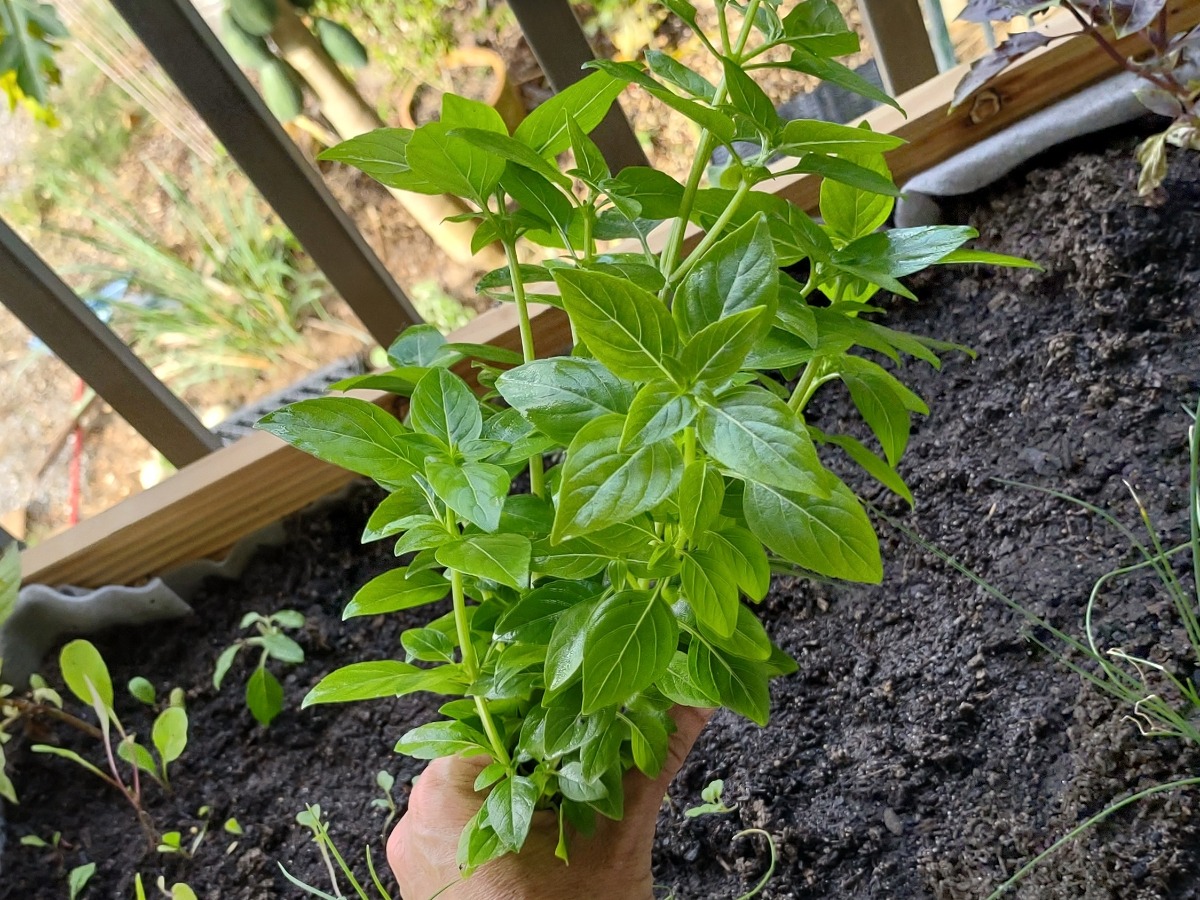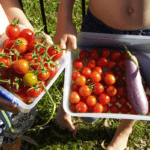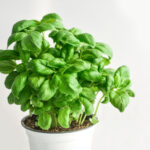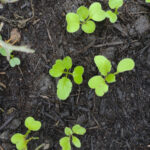This post may contain affiliate links.
Yes, you can grow many types of basil in a tropical climate, with great success. In cooler climates basil is normally grown as an annual, but in our tropical climate you can have great success growing basil year-round, so long as your winter temperatures don’t dip too low.

What Types of Basil Can You Grow in the Tropics?
Everyone’s favourite herb, basil, European or sweet basil grows really well in the tropics if you give it the right conditions. It will probably enjoy some shade from the noon and afternoon sun, but the morning sun seems to help sweet basil flourish.
This is, of course, the basil you associate with pesto, tomatoes, pizza and pasta. It’s a real taste of the Meditteranean and if you give it rich soil with plenty of nutrition, the leaves can get huge. This is my favourite basil and the one we use most in the kitchen, but it’s not the easiest basil to grow in a tropical climate.
The easiest basils to grow in the tropics are the Asian basils that we associate with Thai or other Southeast Asian cuisines. If you want basil for your curry or stir-fry, grow Asian or Thai basils.
There are actually many varieties of Asian, and even African basil.
Holy basil or tulsi also grows well in the tropics, it’s almost indestructible and self-seeds (volunteers) everywhere. Tulsi (and the Asian basils) will grow into quite a large bush and do well if you keep cutting them back into a nice bush shape.
Trimming shoots like this always causes more branches and leaves to form, giving you a bushier plant and more leaves for cooking, salads, teas, or medicinal uses.
Tips For Growing Basil in the Tropics?
My number 1 tip for growing more basil would be to harvest by snipping off a branch, take all of the leaves except the top pair, and replant the stems. You will just keep on propagating those stems to grow more and more basil. Those green cuttings are very easy to root in water or moist soil. Just don’t place them in the sun until their roots have had time to fully establish. A plastic bag over a pot of soil with your cuttings can help them along too by trapping moisture and warmth.
Water basil as needed, just keep the soil moist and not soggy. To check the soil’s moisture levels stick a finger in to your first knuckle. It should feel moist. Mulch can help keep moisture in but don’t pile it around the tender stems, leave a small gap for air circulation.
One of the best things about basil is that it gets very little problems with pests, so long as your plant is healthy. A weak plant always attracts more pests.
If you feed your basil plants with whatever good organic fertiliser you have, it should grow well. As we’re looking for big leaves from a basil plant, a high nitrogen fertiliser is great. I use a top dressing of well-rotted manure, plus worm or compost tea. Even diluted urine would be good.
Some ash from your garden bonfire is often helpful too, plus ground eggshells. You should always be feeding your soil, adding organic matter and minerals and keeping it covered to protect the organisms that should be flourishing beneath the surface.
Another tip for growing great plants, bury excess eggs. We have chickens, geese, ducks and guinea fowl. I’f I think an egg may be off or some fail to hatch, I keep them in the freezer until I can put them in the bottom of a raised bed. It helps with nutrients and water retention.
As a bonus, my chickens, goats, and sheep do not eat basil. I guess they don’t like the strong smell. Because of this we use basil bushes as ornamentals to fill out garden gaps and attract pollinators with the beautiful flowers. My basil bed only has to be chicken-proofed to prevent scratching, the chickens won’t actually eat basil.
Stopping Basil From Going to Seed
The Asian basils flower constantly, you can cut them back but flowering is fine and the bees love them.
It’s said that European or sweet basil becomes bitter if it flowers, I haven’t experienced this but just give them some shade, keep them cooler and keep pinching out the tops. It will help them not go to seed.
What Type of Basil To Grow?
What type of basil do you enjoy eating? Grow that type. There’s no point in growing food you don’t like to eat. But, that said, the bees (including native blue bees) love the Asian basil flowers, so maybe it’s worth growing just for them! It’s a really pretty bushy plant too.
When to Plant and Harvest Basil in the Tropics.
I tend to plant basil at any time of year. But in the interests of being scientific, I thought I’d keep a month-by-month record of my basil’s progress. We do have monthly garden updates on this site, for instance, November is here.
I’ll keep this updated for a full 12 months and let’s really see how the basil grows through the months of the year.
I tend to grow basil from seed, not from nursery plant starts, it’s cheaper, and generally you need a lot of basil plants to make pesto regularly.
Basil in April (mid April) The photo at the top of the page was taken in April, autumn, so obviously I was having success with basil at that time of year too.
Basil in October (mid spring)- The basil is growing strongly and we’re harvesting it regularly, all types of basil, particularly European sweet basil. I also sewed new basil seed in mid October, we’ll monitor its progress.
Basil in November (late spring)- The tulsi (holy basil) bushes are getting huge and in need of a haircut. A good prune for all large basil bushes, they will likely be in flower or seed. The European basil is trying to go to seed as temperatures climb, it really needs some shade as summer approaches. The lettuce is trying to go to seed too, it’s really getting hot here. The goat ate the radish tops, unfortunately and my second big cucumber harvest of the year is coming in.







